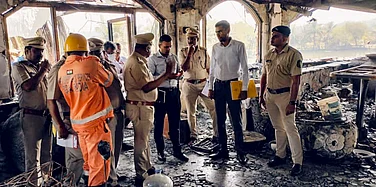An eighteen-year-old succumbed to encephalitis syndrome at Kozhikode Medical College two days ago.
A thirty-eight-year-old woman from Palakkad was shifted to Kozhikode Medical College after her condition deteriorated.
Another patient is battling for life at a medical facility in Manjery, Malappuram district.
Patients infected by the Nipah virus suffer from mild to severe fever, sore throat and myalgia—pains, aches and muscle soreness. In many cases, these symptoms can intensify and cause brain fever, which doctors call encephalitis—a dangerous condition that has neither cure nor vaccine.
It is this worrying set of symptoms that doctors, patients and the public are grappling with in Northern Kerala, where Nipah cases are back once again. The northern districts of Kozhikode, Malappuram and Palakkad are on high alert after the ongoing outbreak, which has already claimed one life, leaving two others to battle for survival.
The health department has issued alerts in the three northern districts, while 383 people are on a contact list of those who might contract Nipah, bringing them under constant surveillance.
The health authorities are tracing the contacts of infected people and deploying quarantine and surveillance measures. Twenty-six coordination committees have been formed to take unified measures to halt the spread of the virus.
Kerala has been witnessing regular reemergence and spillover of Nipah virus cases ever since the first outbreak in 2018, which claimed 17 lives. Though the recurrence has caused panic, experts are confident that the systems developed after the first outbreak are capable of dealing with the situation, even if it worsens.
“Decentralised testing facilities and awareness among the doctors and the public are helping identify cases at early stages,” Dr Anoop AS, who played a pivotal role in identifying and containing the Nipah outbreak in 2018, told Outlook.
Currently the director of critical care medicine at Aster MIMS, a private hospital in Kozhikode, Dr Anoop says that among the reasons for the outbreak being reported in Kerala “for sure, is the robust diagnostic mechanisms established by doctors and hospitals after the 2018 outbreak”.
“Nipah virus infections and deaths might have happened elsewhere too, but in undiagnosed patients. Only in Kerala is the virus routinely screened. All patients with unusual symptoms are tested for Nipah. Patients with acute encephalitis syndrome are monitored more closely and tested to confirm Nipah virus,” he explained. An acute syndrome is when more than one symptom appears suddenly and in a severe manner.
Twenty-two people have died to Nipah infections in Kerala since 2018. The first cases exposed the inadequacies of the state’s health system, but the health department soon strengthened its diagnostic and research mechanisms, helping lower casualties in later outbreaks. In 2023, six were infected, while two succumbed to the disease. Health authorities attribute this lowering of mortality to increased vigilance and screening.
“Patients with Acute Encephalitis Syndrome (AES) and Acute Respiratory Distress Syndrome (ARDS) should be tested for Nipah virus,” said Dr TS Anish, a nodal officer at Kerala One Health Centre for Nipah Research and Resilience. AES and ARDS, he said, are “clinical manifestations”—or symptoms that help doctors identify possible infections. “It is important to find out which virus is causing the AES or ARDS—that helps in early detection [of Nipah cases],” Dr Anish explained.
West Bengal, too, had Nipah outbreaks in 2001 and 2007, but re-emergence has been noted in North Kerala at regular intervals since 2018.
Bats are a reservoir of virus, as are Indian flying foxes, called Indian fruits bats in the Western Ghats in Kerala. The spillover—the term for when a virus leaps from an animal to human host—have occurred, in the majority of Nipah cases, near forested areas.
“Since virus spillovers are almost impossible to prevent, we are now creating awareness and alerting doctors,” says Dr Anish.
Once experts identified the common features of the areas where the Nipah infection was originating, it sparked a discussion on the environmental causes behind the epidemic. Its exact spread from bats to humans is unclear, but experts do not rule out ecological factors as contributing to the jump from animals to humans.
According to Dr George Chandy of the Centre for Wildlife Studies at the Kerala Veterinary and Animal Sciences University, bats need to be monitored closely and their habitats simultaneously protected. He said his department has found in a study that people have been destroying bat habitats, causing stress in the flying mammal’s population and spreading the virus.
“People are scaring bats away by cutting trees and using firecrackers. These cause immense stress and could be major reasons for the virus to spill over. It’s important to regulate human activities around forest areas and take measures to raise awareness. Climate change is also adding to stress in bat populations, which also leads to spillovers,” Dr Chandy said.
Kerala’s clinical protocols can stop the Nipah virus from going out of control—but if there is an environmental link, as experts say, the spread itself cannot be ruled out. The best way to prevent more outbreaks will be to apply clinical protocols along with regulating human-bat interactions.



























